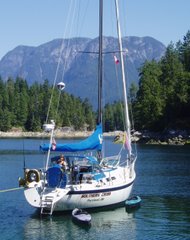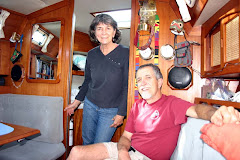By dawn, we were coming abeam of Naitauba Island, home to a religious cult. Vanua Balavu grew closer, until we could see the range markers for Qilaqila Pass. This pass is wide enough for superyachts, so we didn't anticipate any problems. Within an hour we had the hook down in front of Daliconi village, where we needed to perform our "sevusevu", the traditional ceremony by which outsiders are welcomed into the care of the local community and given the right to freely visit its waters. We dressed appropriately - pants or skirt below the knee, nice shirt or blouse, shoulders covered, and most difficult for us, heads uncovered. Hats and sunglasses are considered disrespectful. We rowed ashore with our bundle of dried yaqona. These are the plant roots that are used to make kava, a mildly intoxicating drink popular throughout this part of the world. We were met by Sam and his wife Lako, the chairman and secretary of the village's tourism committee.
They ushered us to a nearby house, where we sat down with a few village elders. It turned out that the village chief and the headman were both absent today, so the ceremony was somewhat abbreviated. Sam presented our yaqona bundle on our behalf. He then gave us a sheet of paper explaining that the village requested a donation of 30 dollars (Fijian) from each person, and that the money was used for community improvements such as school supplies, solar panels, and the like. There is almost no cash economy in these remote villages, so we felt that the request was reasonable. We were given a receipt for our fees. The rest of the ceremony was in Fijian, so we didn't understand what was said, but afterward, Sam told us that the village and its waters were now ours to explore at will, and that he was here to help us in any way required. He took us on a walk through the village, over a hill, and to his family's farm plot. He picked us a basket full of bananas, papayas, and eggplant.


We were still tired from the night passage, so we thanked him and rowed back to the boat for a nap. Soon another boat showed up. It was the Australian-flagged catamaran Lady Nada. Then another, the Belgian-flagged Pamyra Ben, whose skipper Andre we had met in Neiafu a few weeks ago.
The next morning, Sam and two other villagers collected the crews of the 3 yachts, and took us to explore the nearby Bay of Islands. This is one of the most photogenic places in Fiji, and the main reason that so many yachts come to this island group. The shorelines consist of solid limestone karst, heavily forested. The bay is studded with rocky, mushroom-shaped islets, sculpted into fantastic shapes.

We collected more people from 3 other yachts, and then proceeded to a succession of underwater and above-water caves, each more spectacular than the last. We also visited every narrow passage within the bay, and a huge colony of fruit bats.
On the way back to the village, Sam showed us their marine reserve, where they are culturing corals and giant clams. They will use these to restore areas of reef that have been damaged by cyclones. It was a beautiful tour under sunny skies.


That evening, Sam invited us to drink kava at his house. Andre also joined us. We got to take part in the preparation of the kava: pounding the roots into powder with a metal mortar and pestle, putting the powder into a cloth "teabag", and steeping it in water. The kava is served with a lot of ritual, and we enjoyed playing our part. Sam's two sons and their friends entertained us with some very lovely guitar and ukelele music, and sang in beautiful harmony. The effect of the kava was subtle and relaxing, and the taste was not at all bad. Hmm, hope this isn't habit forming!
The next day, Saturday, we followed Pamyra Ben to a sheltered anchorage in Ship Sound, the most intricate part of the Bay of Islands. Chiquita (UK) was already anchored there, and all 3 crews had a nice evening aboard Pamyra Ben. The 54' Morgan cutter has been in Andre's family for nearly 40 years, and he has sailed it all over the world, including Antarctica. Ding has taken Chiquita, a Sweden 50, nearly as far, single-handing much of the way. Compared to yachts like these, poor old Southern Cross seems like a daysailer!


On Sunday, Pamyra Ben took off for Fulanga in the southern Lau group. We may follow in a few days. Later, I tried without success to find a knife that Sue on Chiquita had dropped overboard. The water is only 8 meters here, but not very clear. Sue and I then snorkeled a nearby bommie, where she was surprised to see a 2-meter shark, her first.
On Monday, Vicki and I revisited the bat colony in hopes of getting better pictures. We also scouted out a few more hidey holes capable of holding at least one yacht. Sue from Chiquita rode back to Daliconi with Bill and Sue of Lady Nada, and they all rode the truck to Lomaloma to do some shopping. They kindly re-provisioned us with eggs and bread. In the evening, we joined the crews of Chiquita, Sea Bride (NZ) and Midnight Sun (Australia) for happy hour aboard Lady Nada.
Tuesday, with a GRIB forecast of E 14, we set off for Fulaga, in the Southern Laus, 125nm to the SSE. After 6 hours of calms, torrential rain, and then 15 knots on the nose with increasingly rough seas, we turned tail for Vanua Balavu.






No comments:
Post a Comment